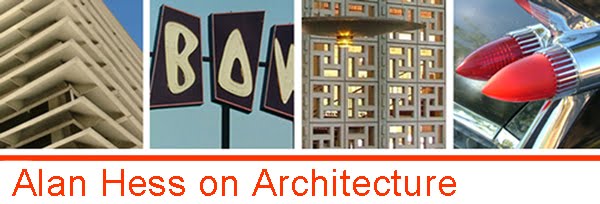The east coast reviews of the Getty's "Overdrive: L.A. Constructs the Future 1940-1990" are beginning to dribble in, and so far they are largely unenlightening. A current exhibit (not part of Pacific Standard Time Presents) at the Pasadena Museum of California Art through July 28 would be useful background for anyone purporting to hold an opinion about "Overdrive."
"California Scene Paintings 1930-1960" (curated by Gordon McClelland) selects water colors and oils from California School artists that are essential views of California, north and south, in that period. They are as useful as the archival photos of the period now being unearthed on excellent Facebook pages like "Vintage Los Angeles," "'The Garden of Allah" novels, by Martin Turnbull" and others, but through color and technique they also convey a layer of emotional meaning of the places that the artists visited: decaying Bunker Hill, Orange County's sun-drenched China Cove beach, Beverly Hills drugstore counters, and Oakland dives. And the expressive insights of these individual artists (including Millard Sheets, Lee Blair with a great portrait of his artist wife Mary Blair at a Palos Verdes picnic, Dong Kingman, Phil Dike, Edward Reep and others) are worth paying attention to if you want to understand L.A.
If not, your opinions on L.A.'s evolution into a Modern City are suspect. Route 66 signs near Upland, freeways under construction, Venice Beach are part of the scene. My favorite is Charles Payzant's "Wilshire Boulevard" from 1936. Here, through
the eye of an artist, are two of the signal Modern buildings of L.A. as they were seen in the Modern city: Bullocks Wilshire department store (1928, Parkinson and Parkinson, architect) and Simon's drive-in (1935, Wayne McAllister, architect.) They are keystones of an urban scene reimagined for the automobile: fashionable Bullocks moving out of the center city to accommodate the Hancock Park gentry arriving in their Packards (probably purchased at Earl C. Anthony's dealership designed by Bernard Maybeck, location of the first neon sign in the U.S.), and McAllister's democratic drive-in welcoming everyone and every kind of car from a Model T to a Packard. The elegant Art Moderne tower of Bullocks is an auto-city landmark along the linear downtown of Wilshire Blvd.; McAllister's Simon's boasts its own Streamline tower, also guiding motorists to this oasis. Payzant captures both towers, both sides of the auto city's culture, and the spectrum of Modern life already thriving in L.A. in 1936. Both are superb designs, but I rather favor Simon's because McAllister (who apprenticed to become an architect) had his finger on the pulse of Modern life, not just Modern architectural theories. Spreading the benefits of modern technology, including the ever-mobile auto, to the masses was one of the true advances of Modern architecture, and the soul of L.A. Modernism. These two buildings in Payzant's painting are an indispensable prelude to the spectrum of buildings presented in "Overdrive."
 |
| "Wilshire Boulevard," Charles Payzant 1936. Private Collection.(http://www.oocities.org/christophermulrooney/criteria/id40.html) |
I'm no art expert, so I'll ask: did any of the buildings of Gropius, Mendelsohn, Le Corbusier or Mies inspire contemporary artists as subjects in their paintings? At least we know McAllister's and Parkinson and Parkinson's did.

Congrats on a truly fascinating piece Alan! Like you, I was intrigued by this exhibition because many of the artists were close friends of the Schindlers, Westons, and Neutras. The Clark Building at 3006 Wilshire by Morgan, Walls & Clements between Simon's and Bullock's Wilshire is also visible in Payzant's painting. The building contained the Stendahl Gallery which can be seen from a different perspective at:
ReplyDeletehttp://3.bp.blogspot.com/-PsPneUk6aZg/TfEAvVup_SI/AAAAAAAACws/RrgNRTpSskg/s1600/Stendahl.jpg
Stendahl moved his Gallery from the Ambassador Hotel to this site around 1931-2 successfully predicting that Earl Anthony's Hancock Park, Hollywood, and Beverly Hills Packard-driving Bullock's shoppers would also beat a path to his gallery door. Payzant likely used his watercolor "Wilshire Blvd."to get his foot in Stendahl's door where he later had some one-man shows.
More on Pazant after a quick Google search inspired by your excellent post. You definitely have a good eye Alan as Payzant's "Wilshire Blvd." won an award of merit at the 12th Annual Juried Exhibition at the Los Angeles Museum in 1931. The show included work by national luminaries such as Thomas Hart Benton, Grant Wood and Marsden Hartley and California artists and Kings Road habitues Conrad Buff, Maynard Dixon, Boris Deutch, Edouard Vysekal and others thus Payzant was almost certainly known to the Schindler-Weston-Neutra circle as he also studied at Chouinard, when Neutra and Schindler were also teaching there and Otis, whose faculty members Edouard Vysekal, Annita Delano, Karl Howenstein, George Stanley and Mary Buff were also Kings Road and Freeman House salon regulars. A good head shot can be found at: http://www.californiawatercolor.com/pages/charles-payzant-biography.
ReplyDeleteValuable information and excellent design you got here! I would like to thank you for sharing your thoughts.
ReplyDeletemodern architecture los angeles
interior designers los angles ca